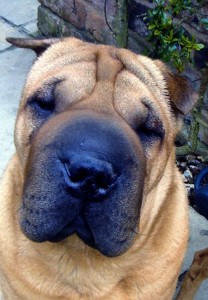Nowadays many welfare and veterinary organisations are trying to become much more conscious of the images they use in their marketing and the messages this sends to the pet owning public. For example when talking about social animals like rabbits they should never be photographed alone. They seem like little things but it’s brilliant for sending consistent subliminal messages about the best way to keep our pets. It’s always disappointing to see advertisers using deformed or diseased animals in a ‘cute’ way such as horribly wrinkled dogs like Shar-peis to sell anti-ageing creams or ‘comical’ short-faced dogs dressed up in an appealing way. When vets look at these dogs we see the disease not the humour and every time one of these extreme breeds is used in advertising or marketing it drives the popularity of many species of animal that often suffer because of their body shape. I was asked to write some guidelines for a vet chain for their internal marketing people to use to help them promote healthy animals. I thought I would add it as a website page in case any other companies or marketing groups want to do the right thing. Please feel free to contact me via Facebook or Twitter if you’d like more help or would like me to cast an eye over your materials or campaigns.
Breeds not to be used. If you want to be on the safe side ask a vet!
Dogs;
- Basset
- Bloodhound
- Boxer
- Cavalier King Charles spaniel
- Chihuahua
- Chinese crested dog
- Chow chow
- Clumber spaniel
- Dachshund – all varieties
- Dogue de Bordeaux
- English bulldog
- French bulldog
- Great Dane
- Mastiff
- Neapolitan mastiff
- Newfoundland
- Pekingese
- Pug
- Shar-pei
- St Bernard
Cats;
- Exotic shorthair
- Manx
- Munchkin
- Persian
- Scottish Fold or any fold variety
- Sphynx cat
Rabbits;
Dwarf, brachycephalic (flat-faced) and all lop-eared rabbits should not be used. Examples of this are;
- Dwarf angora
- Dwarf Hotot
- English lop
- French lop
- Holland lop
- Lionhead
- Mini lop
- Netherland dwarf
- Teddy
Other extreme rabbit breeds to be avoided;
- Angora – all varieties
- Giant rabbits – all varieties
Body shapes in cats and dogs to be avoided in any breed or crossbreed;
Short muzzle
Bulging eyes
Heavy skin folds anywhere on body or head
Drooping eyes
Long back and short legs
Any animals that have a clearly over- or undershot jaw
Teacup dogs
Excessively long ears
- No docked dogs even if exempt breed by law.
- No cropped ears.
- No dogs that are so hairy they cannot see, raise hackles, communicate.
- No hairless varieties of any animals.
- No cats or small pets with excessively long hair.
- No animals being carried in handbags.
- If marketing photos of social small pets like rabbits, Guinea pigs, mice, rats, gerbils, degus should all be photographed with other animals of the same species unless in a clearly clinical setting where you would expect them to be alone.
- No animals in clothes unless strictly for a genuine reason.
- Bear in mind that many animals, including dogs and cats, find close human contact like hugging very stressful. Prey animals kept as pets find being lifted up and carried very alarming. Do not use pictures of children or adults hugging pets or holding animals off the ground. Photos of humans and pets interacting should always be as passive as possible.

